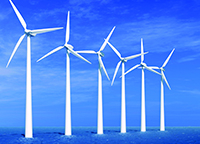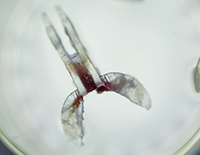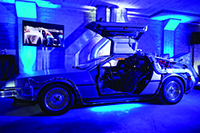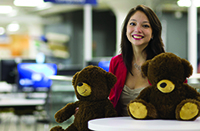Wishing you happy holidays and numerous successes in the new year!
Case School of Engineering's year has been filled with research breakthroughs and academic advances. Explore just a few of our year's highlights:
12+ sensations felt with a prosthetic hand
11 hours scanning an ancient statue to solve an art mystery
10 students developing apps for Microsoft HoloLens
9 test fault locations on a custom-built laboratory scale power grid
8 plugs and ports on a student-built solar-powered table
7 floors of Sears think[box]
In the fall of 2015, the doors were opened on the first phase of the university's innovation and entrepreneurship center—the Larry Sears and Sally Zlotnick Sears think[box], which occupies the 50,000-square-foot Richey Mixon Building and follows the innovation process from ideation to incubation. The innovators' paradise is open not just to CWRU faculty, staff and students, but also to the entire community with no entry cost. Floors two through five are now open, with six and seven scheduled to open in the fall of 2017, and floor one to follow. Explore all the innovation resources of Sears think[box] now.
6 turbines on Lake Erie
Civil engineering researchers at Case Western Reserve are helping a local company build a wind farm off the shores of Lake Erie. Project Icebreaker has spent four years in the making since LEEDCo—the Lake Erie Energy Development Corporation—and Case Western Reserve won a $4-million grant from the Department of Energy to design an offshore freshwater wind farm. The company won a $40-million grant from the DOE this year to get the six-turbine pilot project installed by the end of 2018. University civil engineering researchers have been analyzing core samples from the lakebed to help inform the foundation design and will continue outfit the turbines with a series of sensors to monitor performance once the farm is up and running.
5 new courses for our data science major
Case Western Reserve University officially launched one of the country’s few undergraduate Bachelor of Science degrees in data science and analytics in 2016. Housed in the engineering school, the program expands on the success of the university’s data science minor, which launched in 2013, and will focus on real-world applications. The curriculum includes a number of new Internet-of-Things-related courses developed as part of the rollout of the university’s new Institute for Smart, Secure and Connected Systems, or ISSACS.
4-hour life span for a biohybrid robot
University researchers have utilized organic tissue and 3-D printed parts to develop a "living machine"—a biohybrid cyborg robot designed for search and rescue operations. The 2-inch-long biohybrid robot features living sea slug tissue, because it's designed by nature to function underwater. The robot is built around a single muscle from a sea slug's mouth, which provides movement—the robot can crawl when stimulated by an external electrical field. The research team envisions swarms of these hybrid 'bots scouring the ocean floor in search of a black box recorder, for example, or rooting out the source of a toxic leak in a pond. Learn more about the new crawling cyborg sea slug.
3 days of innovation
Case Western Reserve University, with significant leadership from the Case School of Engineering and Sears think[box], hosted its inaugural Innovation Summit Oct. 26-28, which featured more than 500 visitors and 80 speakers exploring various models of innovation. With speakers including Atari founder Nolan Bushnell, Gallup CEO Jim Clifton, priceline.com co-founder Jeff Hoffman and ARPA-E director Ellen Williams, the summit explored the opportunities and challenges of various models of innovation at the global scale. Watch the highlights video now.
2 virtual hugs
We all crave connection, and sometimes, those closest to us are just too far away. Student and entrepreneur Xyla Foxlin invented a way to send long-distance hugs via wirelessly connected teddy bears. A patent-pending sensor system detects when one bear is hugged and transmits those warm fuzzy feelings via haptic vibrations to its pair-bear anywhere in the world. The mechanical engineering major has been hitting the road promoting her startup, Parihug, garnering attention, top prizes and funding from CES, Disrupt NY, Her Startup Global, South by Southwest and more. Learn more about the digital hug innovation and its creator.
1 controlled fire experiment in space
Space is an unforgiving environment, and a fire on board a spacecraft is one of the most dangerous situations astronauts can face. So why on Earth—let alone off it—would researchers light one in space on purpose? Because a better understanding of how flames behave in microgravity could help keep astronauts safer, which is why aerospace researchers at Case Western Reserve teamed up with NASA Glenn Research Center and scientists around the world to perform the largest fire safety experiment ever conducted in space. Learn more about the microgravity burn experiment, which was the first in a series of six.
and millions of brain waves traveling by new-found means ...
Chemical and electrical synaptic transmission and diffusion of ions are the known ways brain waves can travel—and now, thanks to the research of a university biomedical engineering team, a new method of brain wave propagation has been discovered. Using a small electrical field, individual cells in the hippocampus were discovered to be able to stimulate and synchronize neighboring cells, spreading brain activity layer by layer. The mechanism was noted as a method of transmission for epileptic activity—suggesting a possible novel target for seizure-blocking medicines. Learn more about the brain activity propagation now.



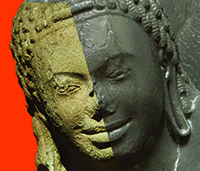
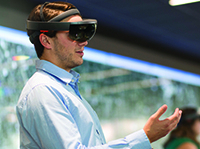
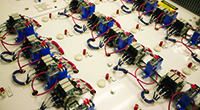
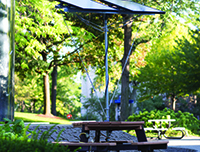
![Sears [thinkbox]](/sites/default/files/styles/page_image/public/searsthinkbox_0.jpg?itok=U2HnNaoM)
